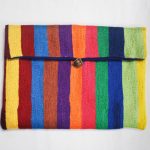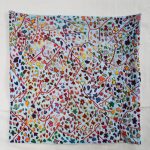Embroidery for the people
- Stitch Sainte Luce
- May 1, 2018
- 4 min read
I first heard about Stitch at the start of my year in Madagascar, in Autumn 2013. The SEED office staff were infatuated with Stitch products – colourful, vibrant, unique and produced locally. They had headbands, bracelets, bags and belts, all handmade with meticulous attention to detail. Even in Madagascar, where people wear a lot more colour than would be normal in the UK, Stitch wares stood out. I couldn’t wait to visit the project for myself a few weeks later when my team was due to be in the area.
About Stitch
Sainte Luce is a remote cluster of three villages, a little further up the coast from Fort Dauphin. Although a mere 35 km as the vasa parrot flies, it takes hours to get there because the road is awful, particularly in the wet season. Add to that the limited, usually expensive options for getting anywhere else from Fort Dauphin, and you have a place which really is isolated. Employment opportunities are limited: for men it’s mostly cassava farming, and fishing, which is seasonal and can be incredibly dangerous. For women it’s mostly housework, and producing goods from mahampy reeds. Fishing, farming and weaving are all dependent on a volatile, changing environment, and cannot support much larger populations than the present. In other words, it’s high time for a little diversification.

New studio interior
In the early days, Stitch was based out of a rented room in the local environment association office. Set up by a former volunteer, Sarah Brown, it was a pioneering attempt to try something new in sustainable livelihoods. Eleven women were selected, and trained in embroidery techniques and design. Stitch began to sell embroidered goods to visiting SEED volunteers, tourists and internationally at craft shows and fairs. Building on early success, a further 12 women were trained as part of the second group, and by November 2014, 359 people in the Sainte Luce had benefited from the project (about 18% of the three villages). Wages were being invested sensibly too, paying the education costs for more than 50 children, as well as food and building new homes. In 2015 the project reached new heights, with the construction of a purpose built studio in Sainte Luce, allowing the women to work with proper light and a dedicated space for the first time, plus a shop for exhibiting and selling to tourists. Planning for the future continued, with more training in business skills, money management and English. With the support of donors, project development continued in subsequent years, whilst the international market was also developed, with Stitch at more shows and fairs, the addition of an Etsy shop, and a revamped website. In 2018, Stitch is bigger and better than ever. In January, 99 more women joined the Stitch Cooperative, bringing the total membership to 120. With these new members, Stitch can expand further than before, producing more amazing products, a wider variety, and hopefully entering into partnership with retailers, as well as other developments.
Fair stalls

Custom laptop case given to me by some lovely volunteers
My own involvement with Stitch over the last few years has been a real pleasure. Whilst out in Madagascar I was able to give a few basic English lessons (with the help of excellent Pioneer volunteers), and of course bought as much from Stitch as I could carry. Two of the nicest gifts I’ve ever received have been from Stitch, and it’s no exaggeration to say that my flat is half covered in it by now.
On moving back to the UK, it’s been great to introduce Norwich to Stitch, at several craft markets every year run by Norwich Global Village Market. Even at handmade markets where the quality is outstanding, Stitch products are noticeable for attention to detail and sheer effort. For example, one of our cushion covers might take up to a month to embroider, and sells at most for £50. Compare that to a cheap, mass-produced and often screen printed cushion cover, and I’d say the quality difference alone makes the price fair. We have a wide variety of stock, from bracelets at £3, to bags from £15, all the way up to wall hangings. Every single item is one of a kind as it’s truly handmade, and comes with information on the embroiderer who made it.
T
here are a few questions which come up a lot at Stitch stalls. First and foremost, who benefits from sales? The embroiderer who made the product gets most of the profit, and typically a lot of the earnings are then passed on to dependants. We’ve seen wages spent on school fees for children and grandchildren, better diets, and even building homes. The majority of project development costs (such as studio construction) so far have been met by donations from large funders, helping to get the project off the ground.
Customers are also curious about how we work out our prices. The majority of each sale goes back to the embroiderer who made it, providing a fair wage for hours worked. Internationally, we also have to pay transport costs, stall fees and exchange rate fees amongst other things. There are also some project contributions, like training and equipment, and material costs, such as fabric and thread. All of these though, are kept as low as possible.
The third question is my favourite: can I get something custom made? Absolutely! There’s a form for that on our website. If you can describe what you want, or provide a sketch, you can get something that’s not only unique but personal. I’ve recently commissioned a wall-hanging map of Sainte Luce and can’t wait to see how it comes out!
Where we’re going
Stitch have a number of events planned for the next year at various stalls in the UK. For my part, I’ll be at The Forum, Norwich, 4th – 5th May, and again September 29th – 30th for the African & Caribbean Market. Keep an eye on the Stitch Twitter and Instagram pages for details of future events!
In the long term, the goal for the project is independence and self-sustainability. We’re continuing to work on business and English skills within the co-operative, so that one day the project can carry on without the support of SEED. This requires further international market development, online, at markets and in retailers. There’s a long way to go, but I’m optimistic – the change wrought in Sainte Luce is already palpable; it just has to become permanent.
Daniel Wood is a former volunteer coordinator for SEED Madagascar. Now back working in the UK, he continues to help out with the SEED website, as well as several Stitch stalls a year.








Comments